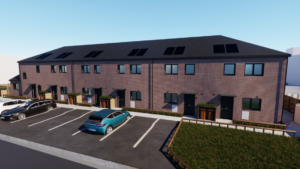If we’re serious about sustainability, why is the car still king?
We know our reliance on cars is bad for us – bad for our health, bad for the environment and bad for the economy. Yet the way we plan and build continues as if it were still the 1950s and the car a watchword for freedom.
Shortsighted transport planning has damaged many towns over recent decades. From clone towns to subtopia, bland, near-identical housing developments have encircled us with car-dependent ghettoes for increasingly scarce nuclear families. Fancy a faux-Georgian box with parking for three cars? No problem. Fancy walking to the shops? No chance.
Business parks with football pitch sized car parks have sprung up by main roads. Retail parks – originally home to DIY superstores – now house what used to be high street brands like Next and M&S.
Local planning and transport has been pretty clear for some time that these patterns of development are not desirable. A quick flick through virtually any local transport plan reveals positive language about reducing reliance on the private car, improving public health, revitalising the town centres and tackling carbon emissions.
There are many reasons why policy has failed to match practice, including everything from simple inertia to corporate bullying. It has never been the case, however, that development based around better public transport and active travel couldn’t work – it does.
Take Kilnwood Vale – a 2,500 house extension of Crawley in West Sussex. BedZED it isn’t, but county and district councils were serious about avoiding yet another faceless, car-dependent suburb. Instead, they agreed a design intended to minimise traffic generation with roads wide and straight enough to suit buses. Of the three access roads into the development, two are bus only with the third having bus priority.
‘We need transport models that help set where we want to go rather than focusing on where we’ve just been.’
Major city centre regeneration schemes like Hull and Liverpool have their detractors, but building in improved public space and public transport connections have at least made accessibility a virtue and given people the choice to leave the car at home. Even business parks (which so often make a virtue of their plentiful free parking) are getting in on the act. When complete, the Quorum Business Park near Newcastle will host 8,000 staff over 1.5 million square feet of office space. Despite its location being selected because of easy access to the trunk road network, fewer than half of staff are expected to arrive by car. This is being achieved through a mixture of soft and hard measures with limits to parks spaces being complemented with a full-time travel co-ordinator to advise of alternative ways to getting to work, strong public transport links with discounted ticket prices, the establishment of cycling routes and initiatives such as free bike workshops all contributing.
None of this is perfect nor is it representative of most new development. But it is a definite improvement and the challenge is to nurture it. So how do we make more of it happen?
First, planning guidance needs reform so economic growth is no longer allowed to trump essential considerations like environment and health. We need transport models that help set where we want to go rather than focusing on where we’ve just been. Finally, we must be bolder. We need to overcome outdated views about the effectiveness of public transport and plan new development which actively discourages over-reliance on cars and supports walking, cycling and public transport.
















The Local Government Act 2000 (surprisingly not repealed, but that may be because it also provided the impetus for cabinets and scrutiny committees, rather than a properly democratic committee structure) gives equal weight to economic, social and environmental wellbeing. How has economic been allowed to dominate to such a disastrous extent? If a developer says their hideous car-centred development will produce £X economic gain, or Y jobs, councillors and officers fall over themselves to accommodate it, despite the fact that X and Y usually turn out to be fiction. There are honourable exceptions of course, Newcastle and Crawley evidently among them. Winchester, on the other hand, has just allowed a 2000 dwelling development which actively reroutes a main road through the centre, instead of leaving the main road where it is and taking a minor road through the development.
Coming out of a study of community transport initiatives (specifically, community bike workshops) I am convinced there is a difference between ‘supplying’ more sustainable transport modes and creating ‘demand’ for them. The tasks are different. It is straightforward to create some forms of ‘supply’ through the conventional planning system – you have outlined new built environments and developments that do this. Road treatments, new cycle lanes, are other examples. It is relatively harder to do what Bordeaux and other cities have done in terms of supply – invest massively in public transport, or Copenhagen’s efforts since about the 1970s to support cycling and later to build a metro. This is the ‘if we build it, they will come’ approach.
The ‘demand’ focus is different. It involves creating or nurturing demands and desires to do something other than sit in a polluting vehicle, and to transfer to ‘active modes’, lobbying for them if they are absent. Planners have much more difficulties with this. It means focusing on the ‘culture’ of transport – the desire of kids to cycle to school for example, rather than the provision of cycle lanes that may remain empty if cycling is not deemed cool enough, or supported enough. Brussels, where I was based, has this problem. Many fantastic planning initiatives and cycle lanes in certain parts, but a population that mostly does not cycle (only 3% do), and only takes public transport when it is clearly the most efficient option vs cars. Over 36% of cars on the roads are company ones, which just increases lazy travel (hard to solve: it is to do with Belgium’s tax system).
I would argue ‘demand’ increases, which begin at school ages and which the Dutch have mastered better than anybody, are the reason that progress towards sustainable mobilities are so slow, rather than ‘supply’ in many cities. When governments do not facilitate an increase in demand, and mostly they do not since education campaigns have a chequered success rate, citizens are quite able to doing it themselves. Community bike workshops and their support of velo-autonomy, better transport ethics, etc. are good examples; so are activist organisations, user groups, and work in schools (see website)